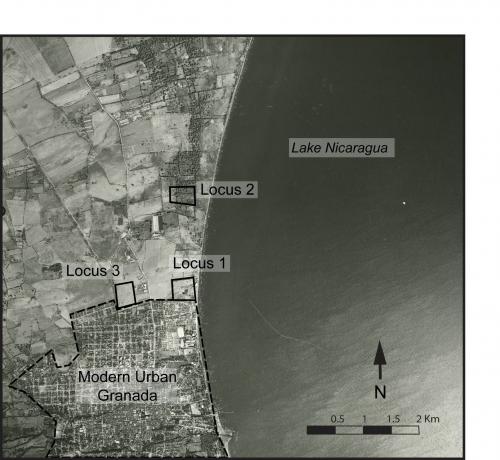Granada
In 2008 we began a new project in Pacific Nicaragua, centered around the modern city of Granada. Initial excavations were conducted at the site of Tepetate on the outskirts of Granada (Fig. 1). Tepetate was probably the Contact-period town of Xalteva, an important town of the Chorotega. culture. Unfortunately, Tepetate has been badly disturbed by modern construction and intensive looting. We were fortunate to be able to excavate one of the only remaining mounds at the site, probably dating to the Postclassic Sapoa period. Other excavations encountered two clusters of urn burials, also Postclassic in age. Future research will continue the exploration of Tepetate but will include other sites known from the region based on Silvia Salgado's (1996) regional survey.

Figure 1: Air photo of modern Granada, with Tepetate on northern edge of urban zone
In 2009 we moved to the site of El Rayo, a Postclassic site located on the shore of Lake Nicaragua near the base of the Mombacho volcano on the top of the Asese peninsula (Fig. 2). Three loci were excavated: Locus 1 was a cemetery exposed in a road cut; Locus 2 was a multi-component domestic area spanning the Late Bagaces to Sapoa periods; and Locus 3 was a ritual area with multiple burials and a small shrine dating to the Sapoa period. Work continued in 2010 at Locus 2, with investigations around a retaining wall discovered in the previous season. Several architectural features were revealed, relating to both the Late Bagaces and Sapoa occupations. Field clearing near Locus 3 exposed several additional mounds, which were explored using shovel test pits.

Figure 2: Location of El Rayo site on Asese peninsula
A new grant application is being prepared to continue research at El Rayo, hopefully beginning in 2012.

